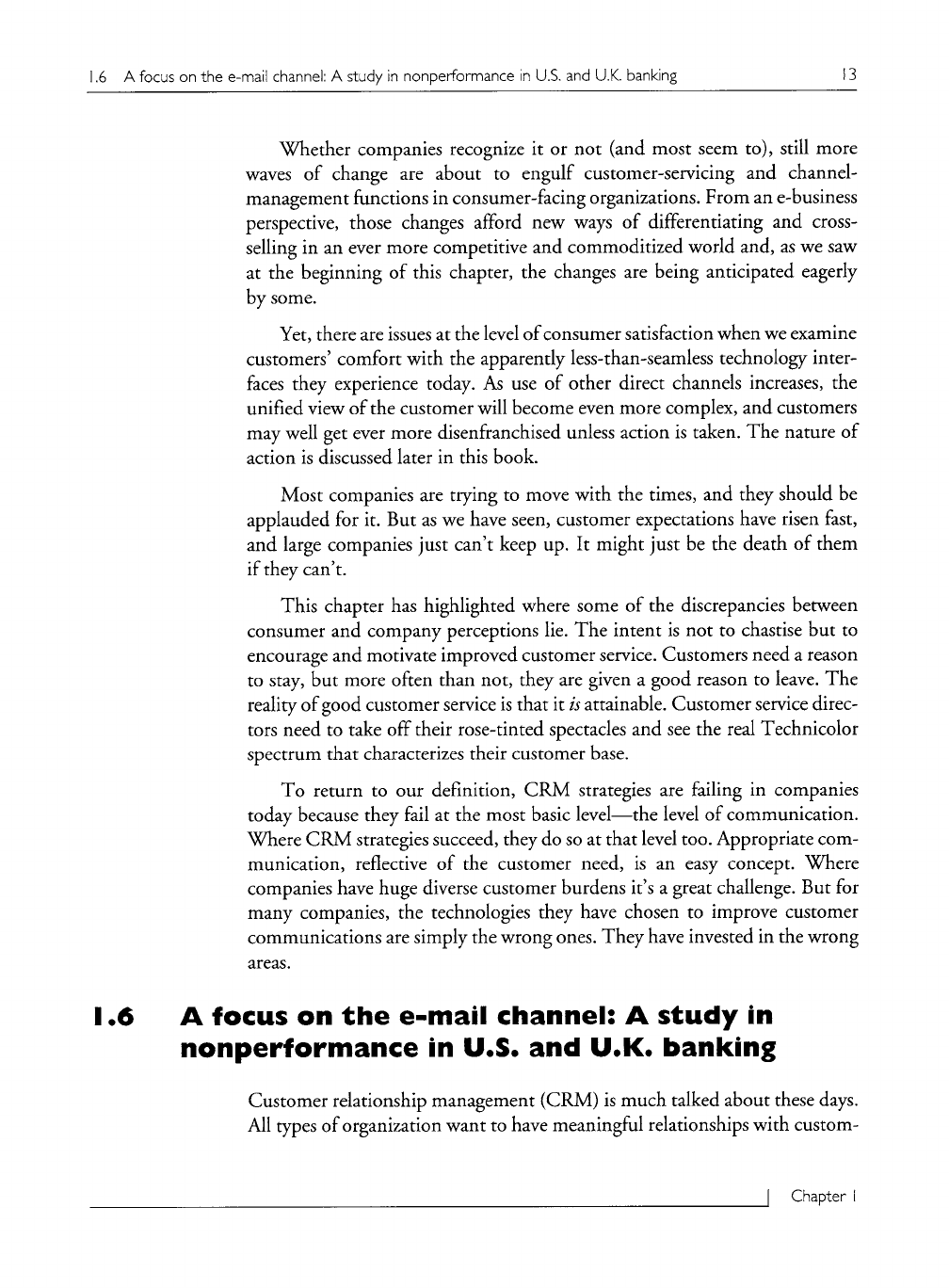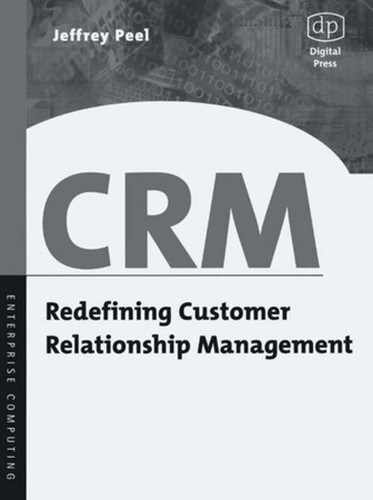
1.6 A focus on the e-mail channel' A study in nonperformance in U.S. and U.K. banking 13
1.6
Whether companies recognize it or not (and most seem to), still more
waves of change are about to engulf customer-servicing and channel-
management functions in consumer-facing organizations. From an e-business
perspective, those changes afford new ways of differentiating and cross-
selling in an ever more competitive and commoditized world and, as we saw
at the beginning of this chapter, the changes are being anticipated eagerly
by some.
Yet, there are issues at the level of consumer satisfaction when we examine
customers' comfort with the apparently less-than-seamless technology inter-
faces they experience today. As use of other direct channels increases, the
unified view of the customer will become even more complex, and customers
may well get ever more disenfranchised unless action is taken. The nature of
action is discussed later in this book.
Most companies are trying to move with the times, and they should be
applauded for it. But as we have seen, customer expectations have risen fast,
and large companies just can't keep up. It might just be the death of them
if they can't.
This chapter has highlighted where some of the discrepancies between
consumer and company perceptions lie. The intent is not to chastise but to
encourage and motivate improved customer service. Customers need a reason
to stay, but more often than not, they are given a good reason to leave. The
reality of good customer service is that it
is
attainable. Customer service direc-
tors need to take off their rose-tinted spectacles and see the real Technicolor
spectrum that characterizes their customer base.
To return to our definition, CRM strategies are failing in companies
today because they fail at the most basic level~the level of communication.
Where CRM strategies succeed, they do so at that level too. Appropriate com-
munication, reflective of the customer need, is an easy concept. Where
companies have huge diverse customer burdens it's a great challenge. But for
many companies, the technologies they have chosen to improve customer
communications are simply the wrong ones. They have invested in the wrong
areas.
A focus on the e-mail channel: A study in
nonperformance in U.S. and U.K. banking
Customer relationship management (CRM) is much talked about these days.
All types of organization want to have meaningful relationships with custom-
] Chapter I

14 1.6 A focus on the e-mail channel: A study in nonperformance in U.S. and U,K. banking
ers. The language of marriage has entered commercial life. People do not buy
things any longer; they augment their relationship with a supplier. And, from
the supplier's point of view, that presents powerful opportunities for cross-
selling, targeting, and clustering.
The problem is that most people do not choose to have relationships with
organizations with which they do business. They just want to buy the widget
or service and move on to something more important. And that is particularly
the case with the Internet. The Internet is a handy channel to market and
a means of payment exchange but do people want a relationship with a
dot-com?
There are certain types of organizations with which people do want a
relationship, according to a recent survey in the United Kingdom com-
missioned by CSC, a leading IT service provider. It asked 1,000 mobile
phone-toting consumers what type of organization they might want to com-
municate with using the Internet and mobile phone technology. The top
answer was the bank at 53 percent; second was the telephone or power com-
pany (36 percent).
Retail bank customers do value a relationship. Ironically, some of the
most successful banks, from a customer-care point of view, have been the
direct telephone banks. Direct banking cognoscenti wax lyrical about how
wonderful and helpful the phone staff are.
Research conducted for software firm Amacis focused on how well the
banks were doing in cultivating valuable relationships with their customers
using the Internet. There were two aspects of the research. The first was a mys-
tery prospecting exercise, which entailed Web forms and e-mail messages
being sent to a variety of banks and building societies that have a Web
presence and tracking how successful they were in dealing with the communi-
cation. The second was a survey conducted by research firms MORI (in the
United Kingdom) and Roper Starch (in the United States) that polled the
opinions of Internet banking strategists in a range of U.K. banks, building
societies (a type of bank that provides primarily home mortgages), and
Internet-only banks. Similar research was conducted with the leading U.S.
banks as well, but the findings were not significantly different from those of
the U.K. study.
In the mystery prospecting study, we sent a standardized request for infor-
mation containing one simple and one more complex question. We assessed
the banks' performances in dealing with the communication at a series of
levels:

1.6 A focus on the e-mail channel: A study in nonperformance in U.S. and U.K. banking 15
1. Was an auto-reply generated?
2. Was a query or case number allocated?
3. Was a considered, helpful response ultimately generated?
4. Were all the issues addressed?
5. How timely was the response?
In many instances we received no response. Several of the United King-
dom's leading banks were in the "never responded" category. This is ironic.
Despite the investment of millions of pounds in Internet infrastructure, they
failed to respond to a customer prospect with a few simple queries. The banks
that performed best were noted for customer service in other areas. The
Internet-only banks did moderately well but not as well as regional or "bou-
tique" banks. However, with a few notable exceptions, it appears that most
banks and building societies are mediocre at best and nonresponsive at worst
in communicating with customers via the Internet.
Findings from the MORI survey shine some light on why this might be
the case. According to the respondents, only 8 percent of U.K. bank cus-
tomers currently communicate with banks by e-mail. This may be an over-
statement. The bank respondents predict that in three years' time, 22 percent
of customers will communicate this way. That may be an understatement.
Therefore, the business processes will soon have to be implemented to allow
the flood of Internet communications.
And a flood it will be. Some two-thirds of our respondents feel that the
Internet will be among the top three banking communications channels,
alongside branch and telephone banking. In terms of the percentages of cus-
tomers using these channels, respondents felt that while branch banking will
experience a decline in the number of customers (down from 57 percent to 50
percent), Internet banking customers will account for 31 percent of the total,
and the telephone banking customer base will remain static at around 38 per-
cent. This implies that the bank model of the future will have fewer branches
and new infrastructure to support additional electronic and mobile communi-
cation channels.
Multiple communication channels make the task of managing customer
relationships more complex. On their own admission, many banks have no
formal method of managing the process of customer communication via the
Internet.
Some 54 percent oflnternet strategists surveyed agreed or strongly agreed
with the statement "integration oflnternet banking with our existing systems
I Chapter I

16 1.6 A focus on the e-mail channel" A study in nonperformance in U.S. and U.K. banking
is the biggest challenge we face." Some 58 percent also thought the main bene-
fit of offering an Internet-based banking service was reduced cost. The
implication is that Internet strategists see a huge short-term hurdle to be over-
come, with considerable investment, before Internet banking starts to pay
its way.
The reason for this perception seems to be that systems being put in place
for Internet banking are not supporting a holistic view of the customer. Imple-
menting Internet-only solutions is no way to facilitate a better relationship
with customers; they will continue to use multiple communication channels.
The objective must be to unite a multiplicity of channels.
Few retail banks appear to be committed to this approach, but some
appear ready to take the plunge. HSBC Bank, with the experience of success-
ful PC banking and direct banking under its belt, has made clear its intention
to fully embrace the Internet as a core channel and put in place the necessary
CRM applications. Others are making similar noises.
Some 42 percent of our respondents indicated that they were looking for
a solution that would allow them to manage e-mail and mobile messaging and
integrate this with the rest of their businesses. So we can hope that soon all
banks will answer e-mails from customers or potential customers who may
actually want a relationship based on good standards of communication. So
it appears that in banking and presumably in just about every so-called
customer-focused service category, customer e-mails are ignored.
The reason we have focused on e-mail is that it is indicative of a malaise.
All too often CRM strategies are implemented at the level of attempting to put
in place internal processes. For too many organizations CRM equates to sales
force automation systems or call-center applications. E-mail is interesting,
because it has become a very popular communications medium, one that can
be embraced relatively easily. Yet with so much focus on CRM, in many
organizations there just is not enough time available to communicate with
customers.
..................Content has been hidden....................
You can't read the all page of ebook, please click here login for view all page.
